The summit of Masada sits 190 feet (58 m) above sea level and about 1,500 feet (460 m) above the level of the Dead Sea. The mountain itself is 1,950 feet (600 m) long, 650 feet (200 m) wide, 4,250 feet (1,330 m) in circumference, and encompasses 23 acres (9 ha). The “Snake Path” climbs 900 feet (280 m) in elevation. From the west, the difference in height is 225 feet (70 m).
Masada
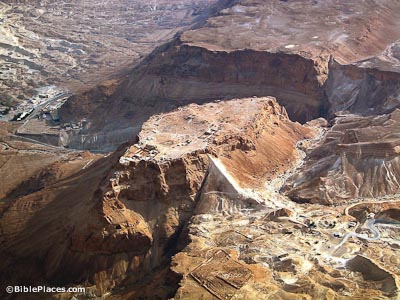
Masada from northwest
Masada Storehouses
Fifteen long storerooms kept essential provisions for the time of siege. Herod filled with them with food and weapons. Each storeroom held a different commodity, as attested by different storage jars and inscriptions on jars in rooms. One of the most interesting finds was wine bottles, sent to Herod from Italy.
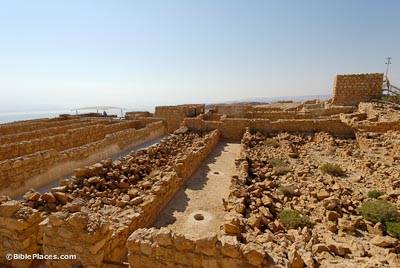
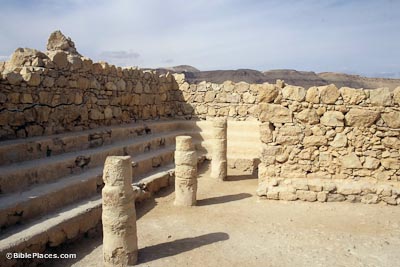
1st Century Synagogue
This synagogue was found in the first season of Yadin’s excavations. No Second Temple period synagogues were known at the time. Many coins from the Jewish Revolt were found here, as well as an ostracon (found on the floor) with the inscription, “priestly tithe.” The back room served as a genizah.
Herod's Bathhouse
Herod had several private bathhouses built at Masada. The caldarium depicted here had a heavy floor suspended on 200 pillars.
Outside the room, a furnace sent hot air under the floor. When water was placed on the floor, steam was created. Pipes were built into the walls to help to heat the room.
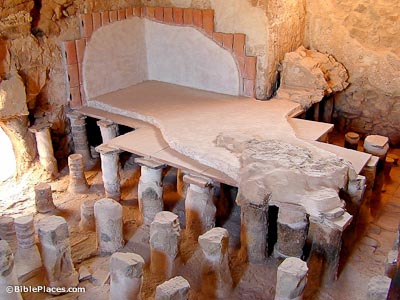
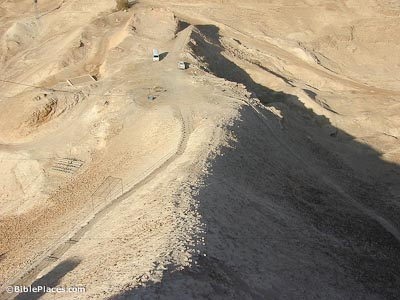
Siege Ramp
Investigation of tamarisk branches in the Roman siege ramp resulted in the conclusion that fifty percent more rain flowed through the wadis into the Dead Sea when Flavius Silva built the siege ramp.
The ramp was built while siege engines and armed men protected the workers. Ultimately, it allowed the Roman army to access the stronghold.
Siege Camp
A solid wall was built surrounding Masada and connected the eight Roman camps. It was 6 feet (1.8 m) thick and 7 miles (11 km) long and built to prevent escaping.
An estimated 9,000 soldiers plus support personnel and slaves conducted the siege.
Szoltan discovered the first Roman siege camps in 1932.
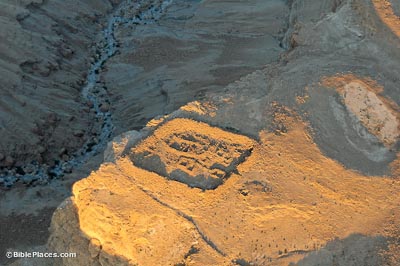

Download all of our Judah and the Dead Sea photos!
$39.00 $49.99 FREE SHIPPING
Related Websites
At BiblePlaces.com, see the related sites of the Dead Sea, En Gedi, Qumran, Qumran Caves, Jericho, and the Judean Wilderness.
Masada Desert Fortress (Jewish Virtual Library) Gives a detailed history of the site and descriptions of many of the important archaeological features of the huge fortress.
The Masada Siege (Bible History Daily) A brief article discussing especially the Roman siege.
Siege of Masada (Britannica) A brief encyclopedic description of the siege that made Masada famous.
Masada (Into His Own) A brief, encyclopedia-type article with multiple links to related words and topics for further study.
Josephus, War of the Jews: Book VII (uchicago.edu) Read the story of Masada in the words of Josephus. Chapters 8–10 deal specifically with Masada.
Masada, Tragic Fortress in the Sky (Times of Israel) A fairly lengthy article about the site, and an interesting read if you can ignore the over-abundant ads.
The History of Masada (History Hit) Another helpful article with several nice photographs.
Masada Synagogue (Madain Project) Included here for the fantastic collection of photographs of the synagogue.
Masada—A Place of Sanctuary, Suicide, and Inspiration (Wayne Stiles) This article includes several photos, history, and a devotional thought.
Masada (Zionism and Israel) This article is quite long, and gives the classic history of Masada, along with some arguments against it, even calling it a myth. Offers a unique perspective, compared to much of what is linked here.
Masada: The Dead Sea’s Desert Fortress (PDF ebook from Biblical Archaeology Society) This ebook includes five essays from various archaeologists (including Ehud Netzer and Jodi Magness) related to the topic. For those who want to dive deep, this is a wonderful resource.
Masada essays (Jerusalem Post, listed on PaleoJudaica) Four 2019 articles on Masada, including one by Jodi Magness.
Masada (Tourist Israel) The information you want to visit there today.